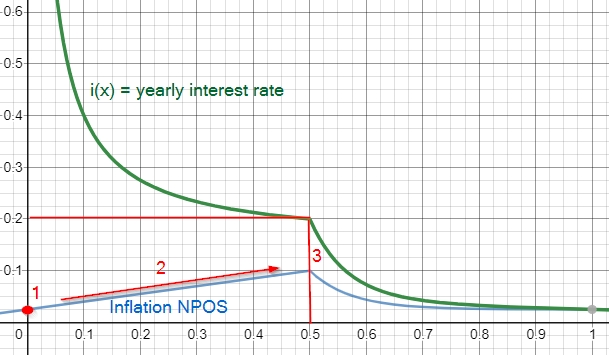Inflation Design
The CLV chain adopts the same inflation design as Polkadot's, as it's a proven and long-term economical design that we think fulfills the future development of the CLV ecosystem.
Inflation to validators is dynamic, between 2.25% - 20% annually, depending on $CLV staking rate on CLV Mainnet.
Although the total number of $CLV in circulation is the combination of the number of tokens on 4 chains ($CLV on Ethereum, BNB Chain, CLV Parachain and CLV Mainnet), the inflation model is only subject to the amount of $CLV circulating on the CLV Mainnet.
0%
2.25%
>125%
>1,500%
5%
3.25%
5.42%
65%
10%
4%
3.33%
40%
20%
5.5%
2.29%
27.5%
25%
6.25%
2.08%
25%
30%
7%
1.94%
23.3%
40%
8.5%
1.78%
21.3%
50%
10%
1.67%
20%
60%
4.38%
0.61%
7.3%
70%
2.97%
0.35%
4.2%
80%
2.62%
0.28%
3.3%
90%
2.53%
0.23%
2.8%
100%
2.51%
0.21%
2.51%
Inflation & Staking Rate Formula

The value of the staking rate should lie between 30% and 60% - ideally at 50%. If it falls, the security is compromised, so we should give strong incentives to $CLV holders to stake more of their assets. If it rises, we lose liquidity, so we should decrease the incentives sharply.
x = staking rate(x is always a value between 0 and 1)
green graph = i (x) yearly interest rate
blue graph = I (x) inflation rate to stakers
x-axis represents the total staking rate, y-axis interest rate (green) or inflation to validator rate (blue)

Number 1 displayed in the graph is the minimum of the inflation to stakers (i.e. when neither validators nor nominators are staking $CLV). It’s the inflation “starting” point; 0.025 → 2.5% in this case goes away for validator rewards.
The second number shows a linear increase of inflation if the staking rate is between 0 and 50%. There is a linear correlation between the staking rate and inflation till 0.5 is reached. The inflation rate is 5% if the staking rate is at 25%. If the staking rate doubles to 50%, so does the inflation rate to 10%. But remember: It is only linear till 50% staking rate is reached.
The red line at number 3 is the ideal staking rate of 50%. In this case, the annual staking reward is at 20%. But if the staking rates exceeds 50%, there is an exponential decay in inflation, which results in a strong decay of staking rewards. The reason for that is that the network needs liquidity and decreases the incentives sharply if the staking rate exceeds 50%.
For Further Reference (Polkadot inflation design 2021):
Polkadot’s Tokenomics and Interoperability - Coinbase Research
Polkadot Inflation and Staking Reward Analysis - Swiss Staking
Economics of Polkadot - Polkadot Blockchain Academy
Web3 Foundation’s Overview of Polkadot’s Token Economics - Web3 Foundation
Last updated